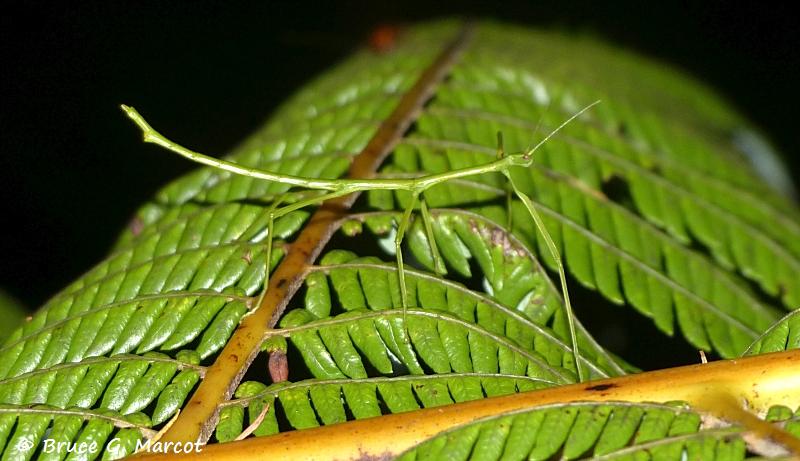
|
|
What To Learn From A Stick |
|
|
Click on images for larger versions
|
Smooth Stick Insect (Clitarchus
hookeri), Family Phasmatidae |
Credit & Copyright: Dr. Bruce G. Marcot
Explanation: This green twig sitting on a fern is actually a smooth stick insect that we found in the dead of a dark night in Waipoua Forest, northern North Island of New Zealand. It is relatively common but restricted to New Zealand, and tells some interesting stories about reproductive strategies, survival, and glaciers.
Let me explain.
First, a bit about this organism. Sometimes green, sometimes brown (see below), they are masters at crypsis or hiding in plain sight, looking all the world like some tossed tree twig. They even sway back and forth at times like twigs in the wind. They usually feed at night mostly on leaves of specific tree species. Females are larger than males and can grow up to over 100 mm (over 4 inches) in length.
Brown form of the smooth stick insect of New Zealand.
It is very easy to overlook them, as they mimic sticks but also,
as shown here, the mid-veins of leaves.
Now, here's the really interesting part.They breed either sexually with males and females, or asexually only as females that can still give birth by "parthenogenesis" -- reproduction without fertilization.
Moreover, as some studies have shown (Buckley et al. 2009), males are completely absent from South Island, New Zealand, are very rare in southern North Island, and are common in northern North Island, where I took these photos. Where males are absent or rare, the insect reproduces by parthenogenesis. Where males occur, they reproduce sexually.
How did this evolve?
It turns out that it all has to do with glaciers.
During the last glacial maximum period (before 12,000 years ago), the species was likely restricted to refugia in northern North Island and perhaps along the east coast of South Island. When the glaciers receded and habitable land opened up, they spread most quickly with female-only populations reproducing asexually, recolonizing the land.
Furthermore, the species currently is most diverse genetically in northern North Island -- the two-sex situation -- and least diverse in South Island -- the one-sex situation. Where females-only occur, they have mostly lost the capacity for sexual reproduction (Morgan-Richards et al. 2010).
So there you have it, what to learn from a stick: a story of reproductive strategies, survival, and glaciers.
Information:
Buckley, T.R., K. Marske, and D. Attanayake. 2009. Phylogeography and ecological niche modelling of the New Zealand stick insect Clitarchus hookeri (White) support survival in multiple coastal refugia. Journal of Biogeography 37(4):682-695.
Jewell, T., and P.D. Brock. 2002. A review of the New Zealand stick insects: new genera and synonymy, keys, and a catalogue. Journal of Orthoptera Research 11(2):189-197.
Morgan-Richards, M., S.A. Trewick, and I.A.N. Stringer. 2010. Geographic parthenogenesis and the common tea-tree stick insect of New Zealand. Molecular Ecology 19(6):1227-1238.
Trewick, S.A., J. Goldberg, and M. Morgan-Richards. 2005. Fewer species of Argosarchus and Clitarchus stick insects (Phasmida, Phasmatinae): evidence from nuclear and mitochondrial DNA sequence data. Zoologica Scripta 34(5):483-491.
Next week's picture:
This Gecko Is A Dwarf
< Previous ... | Archive |
Index |
Location | Search | About EPOW | ... Next >
|
|
Author & Webmaster: Dr.
Bruce G. Marcot
Disclaimers and Legal
Statements
Original material on Ecology Picture of the Week ©
Bruce G. Marcot
Member Theme of The Plexus